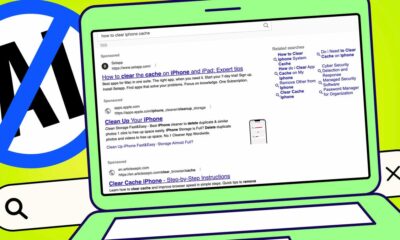PPC
5 Social Media Advertising Tips to Nail Your Efforts and Get Your Expected Results

Do you want your social media advertising efforts to succeed?
Of course, you do.
According to data, brands saw 33% more purchase intent from exposure to LinkedIn ads.
The figure highlights how ads are more than just one of the social media marketing trends of 2022.
With the right strategies, social media ads can help you raise awareness, boost website traffic, generate leads, and grow your sales.
Jumpstart your efforts to optimize social media advertising with the five tips below.
Let’s get right to it.
1. Set Clear Social Media Advertising Goals
Reaching your goals is challenging if you don’t have a clear set of objectives to run your social media ads.
You need to know what you want your social media advertising efforts to achieve since this will shape and inform your strategy.
It can also help you choose the right tools, audiences to target, and the best platforms to run your ads.
For example, if your goal is to boost your engagement rate, you could run ads with trending or popular quotes on TikTok.
It’s one way of drawing more eyeballs to your ads while engaging audiences with familiar content.
Your social media advertising goals can include the following:
- Raise awareness
- Expand your brand’s reach
- Drive traffic social traffic to your website
- Boost your engagement rate
- Generate more leads, clicks, and downloads
- Increase your conversions and sales
Once you’ve identified your goals, you can start looking for the best-fitting tools to help you implement your ad strategy and reach your targets.
Consider platforms such as Vista Social.
The social media management platform helps you plan, organize, prioritize, and schedule your content posting with its content calendar and auto-publishing features.
Identify your social media advertising objectives to determine how to best implement your strategy.
Your goals can also tell you what metrics to track and measure to assess your ad’s performance.
2. Understand Your Audience and How They Spend Their Time Online
Get the best bang for your buck by targeting audiences who need or want your products, services, and offers in your ads.
After all, you’re not likely to achieve your social media ad campaign goals if you advertise to the wrong audience.
For instance, running ads about your UI/UX software to people looking for reliable security testing tools won’t get you conversions.
Know your target audience by developing personas (or refining your existing ideal buyer personas).
It can help you understand the people and segments to target and focus your social advertising efforts on.
Use Facebook Audience Insights to get an overview of your target audience demographics, interests, liked pages, activities, etc.
Understanding your ideal buyers can help you to tailor your social media ads to their pain points and needs. It can increase the chances of your audiences clicking on your ads and acting on your offers.
It also helps to know how your audiences spend their time online, including the social media platforms they frequent.
Doing so gives you a good idea of the social media channels you should focus on and the content types that appeal to your potential customers.
For instance, most younger audiences (teenagers to early 30s) are on Instagram. Visual elements such as images and videos work best for running ads on the platform.
Determine your ideal buyers’ preferences, main interests, and the platform on which they’re most active.
Use the information to create social media ads that cater to your target audience’s needs, making your content irresistible.
3. Learn About Your Social Advertising Options
While casting a wide net by advertising on multiple social media platforms can have certain benefits, it can also be tedious and resource-draining.
The key is to focus on at least three social media platforms to run your advertising campaigns. It can help you avoid stretching your team and resources too thin while getting results.
Run ads on the following platforms depending on your social media advertising goals, target audiences, and campaigns.
- Facebook. You can run various ad formats on Facebook, including videos, photos, and carousels that display on users’ news feeds. Other FB advertisement options are Messenger and Story ads.
Facebook also offers the Lookalike audiences feature that lets you create targeted ads based on your known audiences or existing customers.

- Instagram. Instagram offers similar ad formats and audience targeting features as Facebook under Meta Business.
For example, you can run an IG Story ad on how customers can buy SEO articles as part of your efforts to promote your SEO marketing services.
- Twitter. Select or create a tweet that you want Twitter to show people who are not following you to advertise on the platform. You can choose audiences to target based on user behavior, demographics, interests, and who they follow.
The Twitter Promote option can advertise your tweets with a monthly charge.
- TikTok. You can run TikTok video ads with brand filters and branded hashtags. TikTok also provides an automated creative optimization feature. It tests combinations of your video, copy, and images to the ads that work best for you.
Focus on running ads on the social media platforms that make the most sense for you.
Follow content writing time-tested tips to help you create compelling ad copies and Calls-to-Action (CTAs).
4. Test Your Social Media Ads
Test your various social media ads to assess and improve their performance.
Start A/B testing several ads initially with small audiences. It can help you determine the ads (and ad elements) that work best and use the top-performing ad in your main campaign.
You get instant feedback with social media, so you can learn what ads work (and don’t) for your brand faster.
Use a reliable social media ad analytics tool to test your ads and make improvements efficiently.
For instance, Facebook offers a built-in A/B testing feature for your ads.

A/B testing takes away the guesswork on what ad element or variation you need to tweak and improve to get better results.
5. Track and Measure Social Media Ad Results and Performance
Tracking and measuring your social media ad performance can tell you if you’ve reached your targets.
You’ll know whether your social media ads perform well (or not) and what aspects worked and didn’t work. It gives you the information you need to improve your ads moving forward.
Measure your results to get reliable data about your ad’s value to your company, such as leads and purchases, and prove Return on Investment (ROI) or Return on Ad Spend (ROAS).
Develop a well-thought-out content tracking strategy to help monitor and assess your social media ads’ performance and returns.
It can also help you determine if your ads contribute to your entire social media marketing efforts.
Nail Your Social Media Advertising
Social media advertising isn’t as easy as pie, but it’s not rocket science.
Kick off your efforts with this guide’s social media advertising tips to set you on the path to success.
Continue learning, testing, and improving to run effective social media ads that help you reach your targets and get the results you expect.



















You must be logged in to post a comment Login